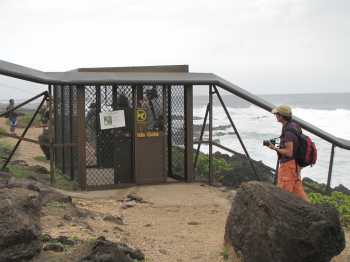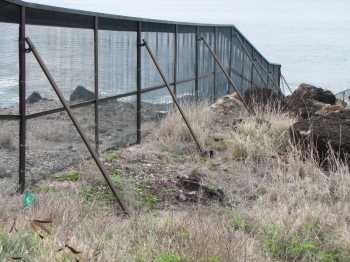When Cole Porter wrote the cowboy song "Don't Fence Me In" for the movies way back in 1934 he pretty certainly did not have albatrosses in mind. However, Lindsay Young and Eric Vanderwerf of Pacific Rim Conservation certainly did when they set up the Ka‘ena Point Ecosystem Restoration Project. The project aimed to erect a predator-proof fence to protect the Laysan Albatrosses Phoebastria immutabilis and Wedge-tailed Shearwaters Puffinus pacificus breeding at Ka'ena Point on the western tip of the Hawaiian island of Oahu from Indian Mongooses, as well as from feral cats and dogs and from rodents.
A party of delegates to the 39th Annual Meeting of the Pacific Seabird Group was taken on a post-conference tour by Eric and Lindsay to the Ka'ena Point Natural Area Reserve to view the birds and the now completed fence. The New Zealand-designed fence is the first erected anywhere to protect albatrosses from all types of introduced terrestrial predators.
Several months on and the fenced area is now free of predators (see meeting abstract below) and the seabirds are breeding well.
A good way to end a conference!





Reference:
Young, L.C., VanderWerf, E.A., Lohr, M., Titmus, A. & Miller, C.J. 2012. A story of predation, eradication and recovery at one of Oahu's largest
seabird colonies: Kaena Point Natural Area Reserve. PSG 2012 Hawaii abstracts. Pacific Seabird Group Thirty-ninth Annual Meeting, Turtle Bay Resort, Haleiwa, Hawaii, USA.
The 20 ha coastal strand ecosystem of Ka`ena Point Natural Area Reserve on Oahu, Hawaii hosts one of the largest seabird colonies in the main Hawaiian Islands and contains 11 species of endangered plants. Due to the negative impacts of invasive mammals on native species, construction of a predator-proof fence was proposed in 2006 and completed in early 2011. Predator removal efforts began upon fence completion and were informed by two years of rat and mouse monitoring. Diphacinone in bait boxes spaced 25 m apart and multiple catch mouse traps spaced 12.5 m apart were deployed to remove rodents (Rattus rattus and Mus musculus) and small Indian Mongooses (Herpestes javanicus). Cats were removed with a combination of cage traps and padded leghold traps. Tracking tunnels were run monthly and spatial maps of rodent catch were generated to determine areas of high mouse activity. Snap traps were deployed in areas of high activity, and bait was switched or refreshed in surrounding live traps in these areas. Cats, rats, and mongooses were eradicated within three months, and mice were likely eradicated after eight months pending verification, though a few incursions have occurred since. The removal of predators has already resulted in a record number of Wedge-tailed Shearwater (Puffinus pacificus) chicks in 2011, and is expected to result in increased Laysan Albatross (Phoebastria immutabilis) reproduction in 2012. Predator exclusion and removal is also anticipated to encourage other seabird species to nest at Ka`ena Point, and to enhance regeneration and recruitment of native plants and invertebrates.
John Cooper, ACAP Information Officer, 24 February 2012

 English
English  Français
Français  Español
Español